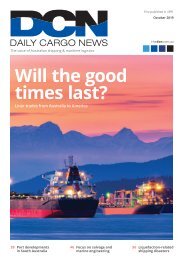DCN September Edition 2019
You also want an ePaper? Increase the reach of your titles
YUMPU automatically turns print PDFs into web optimized ePapers that Google loves.
LINER TRADES TO EUROPE<br />
almost all of the previous port calls offered and, thanks to the<br />
increase in size from NEMO/EAX’s 6300-7300 TEU and AES’s<br />
6250-7500 TEU to the mooted 9500 TEU, little real capacity will<br />
be lost, especially given the reality of how much of this capacity<br />
actually serves the Europe trade anyway.<br />
One coincidental change, a product of internal group<br />
re-organisation of brands rather than service rationalisation, is that<br />
ANL will no longer participate (obtaining slots from parent CMA<br />
CGM) in the Europe trade. However, the ANL and CMA CGM sales<br />
and agency teams are being integrated in Australia and in Europe,<br />
so customer relationships will be maintained, the carriers say.<br />
MULTI-SECTOR PRODUCTS<br />
According to the UK-based Container Trade Statistics, which draws<br />
its data from information furnished by select carriers, Australasian<br />
exports to Europe grew by a strong 5.5% to 52,100 TEU in the first<br />
quarter of <strong>2019</strong>, while imports rose by 2.5% to 173,800 TEU. Freight<br />
rates in both directions were, at best, subdued in the first quarter of<br />
<strong>2019</strong>. (Q2 <strong>2019</strong> figures had not been released at time of writing).<br />
For calendar 2018, exports rose an impressive 8.3% over 2017,<br />
to 199,300 TEU, according to CTS, while imports jumped 6.5%<br />
to 735,900 TEU. Northbound and southbound rates lifted, but<br />
patchily and insubstantially.<br />
CTS figures come with the usual asterisk: “it should be noted<br />
that CTS statistics may be substantially revised afterwards,<br />
when new information and corrections are processed”, and the<br />
underscore that carriers of this end of Australasian trades often<br />
find poor correlation with the figures compiled in the northern<br />
hemisphere.<br />
CTS figures – and those collected by others, such as ports - do<br />
not distinguish between containers carried by direct services and<br />
those transiting via relay. But it is indisputable that the trade is<br />
severely imbalanced: the stats above indicate southbound volumes<br />
are more than three times northbound, and direct service carriers<br />
say it’s more like five times for them.<br />
Which all goes to explain an essential characteristic of the ANZ-<br />
Some think it’s [IMO2020] the Y2K of<br />
shipping, others think it will leave some<br />
lines – especially the smaller ones –<br />
hanging by a thread.<br />
Europe-ANZ direct services, one which we repeat every year but<br />
which bears re-iteration: these are not really direct services. They<br />
are multi-sector products that, while enabling shippers to have the<br />
goods remain on board for the entire journey (excepting changed<br />
operational circumstances) the ships themselves are servicing<br />
multiple markets.<br />
Thus, the CMA CGM/Marfeet PAD/NASP service is really made<br />
up of the following legs: southbound, NW Europe/UK-East Coast<br />
North America (ie trans-Atlantic), NW Europe/UK-South Pacific,<br />
NW Europe/UK-ANZ, ECNA-South Pacific, ECNA-ANZ, ANZ-<br />
ECNA, ANZ-NW Europe/UK, ECNA-NW Europe UK. And you<br />
could probably throw in links over Caribbean/Panama hubs to<br />
Central and South American markets.<br />
The current Suez services, CMA CGM/Hapag-Lloyd NEMO/<br />
EAX and MSC Australia Express Service, can be similarly sectioned,<br />
into Australia-SE Asia, Australia-Indian Sub-Continent, Australia-<br />
Middle East, Australia-Mediterranean and Australia-NW Europe/<br />
UK, with supplementary roles played by intermediate combinations<br />
of which ISC-Med/Europe is the most important. Southbound,<br />
routes follow a NW Europe/UK, Mediterranean, Indian Ocean<br />
islands, Australia format – again with intermediate legs of varying<br />
importance.<br />
The poly-market nature of these services is, as carriers<br />
regularly remind, essential to their viability (and continuation):<br />
“We must have the double- and triple-dip,” one executive says.<br />
“These services would not survive in either direction<br />
without it.”<br />
28 <strong>September</strong> <strong>2019</strong><br />
thedcn.com.au
















